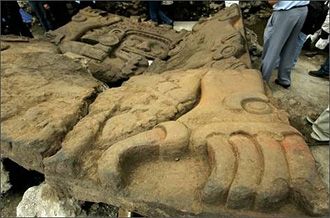 |
 |
 |
 News Around the Republic of Mexico | November 2006 News Around the Republic of Mexico | November 2006  
Experts Say Tomb May Be Under Monolith
 Associated Press Associated Press


| | Once the pit has been explored, the stone - fractured by the weight of the buildings that stood on top of it - will be reassembled and replaced in its original spot. |
Mexican archeologists say they have found signs that the tomb of an Aztec emperor could lie beneath a recently excavated stone monolith showing a fearsome, blood-drinking god.

It would be the first burial site ever found of a leader of the 1427-1521 Aztec empire, said archaeologist Eduardo Matos, who leads the excavation project at the Templo Mayor ruins around Mexico City's main square.

'We think this could be a gravestone covering the place where this ruler was laid to rest,' Matos said Thursday, as he showed reporters the carved face of the stone for the first time since it was discovered Oct.2.

The stone was unearthed at the foot of the western face of the Templo Mayor, the Aztecs' main religious site. Matos said it was found in the same spot where the Aztecs are believed to have cremated their leaders and buried their ashes in funerary jars.

Researchers have spent more than a month removing dirt and stones covering the 4-meter (13-foot) monolith, and hope to begin excavating the fractured stone itself to explore a shallow pit that lies beneath it.

Matos said a date carved on the stone suggests it contains the remains of emperor Ahuizotl (1486-1502), the father of Moctezuma, the Aztec ruler defeated by the Spaniards.

Carvings on the stone show the Aztec god of the earth, Tlaltecuhtli, who is depicted as a woman with huge claws, a stream of blood flowing into her mouth as she squats to give birth. Tlaltecuhtli was believed to devour the dead and then give them new life.

The god was so fearsome the Aztecs normally buried depictions of her face down in the earth. However, this one was found face-up, covered by a layer of stone and mortar placed by the Aztecs.

In the claw of her right foot, the god holds a rabbit and ten dots, indicating the date '10 Rabbit,' or 1502 - the year of Ahuizotl's death.

The site may also hold the key to why more Aztec imperial burials have not been found; the Ahuizotl burial site - if it is that - was apparently covered by paving even in Aztec times.

The Spaniards then built houses on the site, the last of which was damaged in an earthquake and torn down in 1993.

In recent years, minor excavations on the edge of the site revealed the first steps leading up to the Templo Mayor pyramid. It was only accidentally, as they cleared a pedestrian walkway for viewing that staircase, that archaeologists stumbled on the monolith a few meters (yards) to the west.

While the Aztecs founded Mexico City in 1325, they did not establish their empire and begin conquering their neighbors until 1427.

Once the pit has been explored, the stone - fractured by the weight of the buildings that stood on top of it - will be reassembled and replaced in its original spot. | 
 | |
 |



